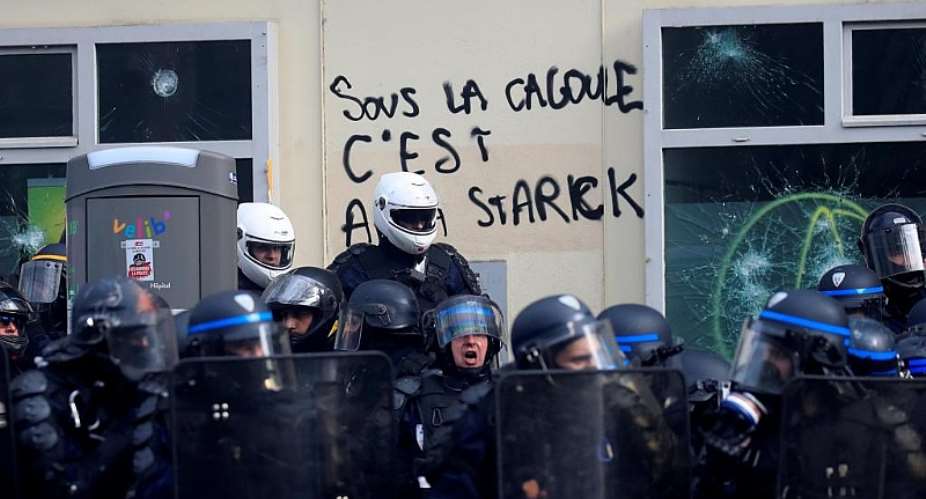Anxious to avoid a repeat of last year's May Day violence, French police took no chances this time round. While some scuffles did erupt, the "worst was avoided," according to the French interior ministry. But the strain on police is taking its toll.
“I think the police probably did as good a job today [Wednesday] as they could have done," comments Jim Shields, an honorary professor in French Studies at Warwick University.
But “how long can they stay on the kind of high alert they've been on?" he told RFI.
The Yellow Vests have been protesting every Saturday since November in demonstations that have often degenerated into violent clashes that have put security forces under intense strain, police unions say.
"They've never been tested like this before," concurs Shields.
This year's May Day event brought both the Yellow Vest movement and masked Black Bloc protesters out onto Paris' streets.
"It is part of the gilets jaunes and the Black Blocs strategy to keep up this constant pressure with no respite and stretch police resources to the limits," he adds.
Strain beginning to show
On Monday, the French government opened a suicide prevention unit for police officers after a sharp rise in the number taking their own lives since the start of the year.
The move came after reports that some Yellow Vest protesters were urging police to "commit suicide" during demonstrations.
“Everybody hates the police!” was a popular chant in some sections of the May Day rallies, although no one chanted "commit suicide" this time round.
While most of the marchers were peaceful, more than 250 people were arrested after police were hit with stones, bottles and other projectiles.
Authorities had warned there could be trouble at this year's May Day marches after months of chaotic gilets jaunes protests. History also has not always been on their side.
Zero-tolerance
"We still recall the two previous May Day protests, notably the one in 2017 when an anti-riot officer was set on fire," French interior minister Christophe Castaner said in an interview to French daily Le Parisien.
This time, "our security forces prevented the worst from happening," he said, boasting that the latter had thwarted a plan by Black Bloc protesters to transform Paris into a "capital of mayhem."
Last year, police were caught off guard by over 1,000 trouble-makers who ran amok in the capital, but this time they adopted a new zero-tolerance policy intervening as soon as the Black Blocs began to form.
"Because our forces applied the principle of systematic intervention from the beginning, during and at the end, the Black Blocs were stopped in their tracks," said Castaner.
Nonetheless, some criticized the "heavy-hand" response of police who fired tear gas and water cannon to disperse crowds.
The head of the CGT union, Philippe Martinez told news outlet France Info that "police charged the CGT", forcing him to temporarily flee the march after being tear-gassed. Other witnesses said the Black Blocs had attacked the union march.
'Age-old problem'
French police now have greater powers to patrol demonstrations owing to a new anti-riot law which opponents claim violate civil liberties.
“There are a number of laws going all the way back to the 1980s brought in to deal with rioting and public order offences at demonstrations," comments Shields, saying these have increased police powers of surveillance and control.
"The problem with all such legislation is that it's retrospective. It deals with offences once they've been committed. It can't predict who's going to riot, where and when," he told RFI.
The anti-riot law gives authorities the power to search bags and cars in and around demonstrations if demanded by a prosecutor. However, in a last minute move, the Constitutional Council, France's highest authority, rejected a provision to bar suspected rioters from assembling. This puts police in a bind.
"It's an age-old problem," says Shields. "Authorities have to strike a balance between civil liberties on the one hand including the right to protest, and public order on the other,” he concluded.





 Lay KPMG audit report on SML-GRA contract before Parliament – Isaac Adongo tells...
Lay KPMG audit report on SML-GRA contract before Parliament – Isaac Adongo tells...
 Supervisor remanded for stabbing businessman with broken bottle and screwdriver
Supervisor remanded for stabbing businessman with broken bottle and screwdriver
 NDC watching EC and NPP closely on Returning Officer recruitment — Omane Boamah
NDC watching EC and NPP closely on Returning Officer recruitment — Omane Boamah
 Your decision to contest for president again is pathetic – Annoh-Dompreh blasts ...
Your decision to contest for president again is pathetic – Annoh-Dompreh blasts ...
 Election 2024: Security agencies ready to keep peace and secure the country — IG...
Election 2024: Security agencies ready to keep peace and secure the country — IG...
 People no longer place value in public basic schools; new uniforms, painting wil...
People no longer place value in public basic schools; new uniforms, painting wil...
 'Comedian' Paul Adom Otchere needs help – Sulemana Braimah
'Comedian' Paul Adom Otchere needs help – Sulemana Braimah
 Ejisu by-election: Only 33% of voters can be swayed by inducement — Global InfoA...
Ejisu by-election: Only 33% of voters can be swayed by inducement — Global InfoA...
 Minority will expose the beneficial owners of SML, recover funds paid to company...
Minority will expose the beneficial owners of SML, recover funds paid to company...
 Prof. Opoku-Agyemang has ‘decapitated’ the NPP’s strategies; don’t take them ser...
Prof. Opoku-Agyemang has ‘decapitated’ the NPP’s strategies; don’t take them ser...
